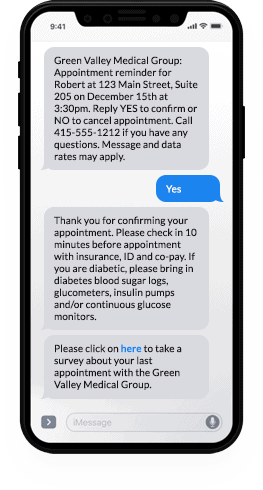
Photo by Tumisu on PixabayPatient reviews are vital for dental and healthcare practices.
When customers are looking for a new doctor, dentist, or specialist, they want to go to someone they can trust. This often means asking friends and family for recommendations or checking out online reviews. I’ve had countless patients referred to me by people they know, and many have told me that they found my practice after seeing reviews online.
In fact, a survey found that 29 percent of potential patients consider social media reviews important when choosing a dentist. Another study found that 20.5 percent of patients cited recommendations from someone they know as a major factor when selecting a new dentist. So why do patients turn to reviews?
Reviews provide social credibility. If other patients have had a great patient experience with a given dentist, the patient can be confident that they’ll enjoy the same. For dentists and other medical practitioners, customer reviews can be used to build trust with patients before you ever talk to them.
Social media makes it easier for patients to share their experiences with friends and family. And online review sites make it easy for them to share their experiences with the world at large. Facebook, Instagram, Google’s business listings, and various other websites and social media networks are fantastic for building up social credibility and gaining trust.
Unfortunately, however, many patients simply fail to leave public reviews. Some patients don’t know where to leave them and don’t realize how important they are for your practice. However, with a little bit of (gentle) prodding satisfied patients will often leave a positive review. Thus, by implementing the right strategy, you should be able to increase the number of reviews your practice receives.
If you check out my own Google listing and Facebook page, you’ll see that I have a substantial number of reviews. This isn’t a bragging right, mind you, but instead a very useful tool for attracting new patients. And in my own experience, these reviews have been a great asset, drawing in new customers and expanding my reputation.
That’s why I’d like to share some methods that should help you increase positive reviews of your own practice. Before reviewing these methods, however, let’s go over why dentists, doctors, and other medical practitioners need to pay attention to patient reviews.
Why Should Medical Practitioners Care About Patient Reviews?
Before going over strategies for gaining patient reviews, let’s take a moment to understand why they are so important for modern medical practices. It’s easy for us medical practitioners to get caught up in the day-to-day realities of running a practice. And many medical practitioners would rather focus on improving their medical knowledge than their marketing skills.
There’s nothing wrong with that. In fact, by focusing on your practice and skills, you’ll be able to provide better care and a better experience. Over time, this should organically lead to more patients, reviews, recommendations, and everything else. However, that’s not enough. You also have to be proactive in your marketing efforts. That means, among other things, proactively encouraging your patients to leave positive reviews.
The fact is, modern medical practices have to compete for patients. Those practices that excel at marketing will have a leg up when it comes to attracting patients. As more people conduct online research and take charge of their healthcare, marketing will only become more vital.
Consider that a 2014 survey found that the number of patients using online reviews increased by 68 percent compared to a year earlier. Further, 50 percent of patients claimed they’d go out of network to work with a medical practitioner who had favorable online reviews.
This data is a bit dated but I believe the trend has only strengthened in the years since. Consider that 54 percent of millennials are already conducting research online before choosing a doctor. Even if you focus on older patients, keep in mind that millennials are a huge cohort, and for many practices, they’ll eventually become your primary customers.
Further, while millennials are perhaps the most tech-savvy generations, others are turning to the internet to conduct research as well. And the first thing patients often find is online reviews.
Why Do Patients Leave Reviews Anyways?
It’s important to understand why patients leave online reviews. Once you grasp a patient’s motives, you’ll have a better understanding of how to encourage them to leave positive reviews.
According to a University of Michigan study, 59 percent of patients reported that online reviews were “somewhat” important, while 19% felt they were “very” important. Among those who sought out reviews, 35 percent selected a doctor based on good ratings, while 37% avoided a doctor because of bad ratings. I’d expect to see similar numbers if we surveyed patients looking for a dentist, chiropractor, or another medical practitioner.
The good news is, while non-medical customers are often motivated by a negative experience when leaving reviews, the same study actually found that patients are more often motivated by positive experiences. So why are medical patients more altruistic with their reviews than customers in other industries?
Digging deeper, another survey found that over 30 percent of patients leave reviews so they can help future patients. 30 percent end up posting about positive experiences, while just over 25 percent post about negative experiences.
Anyways, by now you should be convinced that online reviews are important for your medical practice. So without further ado, let’s jump into some specific strategies you can use to drum up (positive) patient reviews.
1. Start By Simply Asking

Photo by mohamed_hassan on Pixabay
In my experience, the most effective strategy is also the simplest: ask your regular patients if they’ll leave an online review. Admittedly, it felt a bit awkward the first few times I asked but on nearly every occasion, it’s been a positive experience. In fact, some patients even appreciate that you’re reaching out to them for help.
In many cases, my patients simply didn’t realize how important reviews are or where to post them. When I ask my patients directly to leave a review, I make sure to explain why it’s important. Usually, something simple is enough, like “hey Susan great seeing you today. I wanted to ask, would you mind leaving a review for my practice on Facebook? It’d be a big help. I know a lot of patients look at online reviews now.”
Further, a bit of hand-holding can go a long way. Let your patients know where they can and should leave reviews. Does your patient have a Yelp profile? Ask them to leave a review there. Also, Google’s business listings are now very important as they are often the first impression potential patients will see when searching for a new dentist or doctor. Anyone with a Gmail account can easily leave a review. The same can be said for Facebook.
One effective strategy to ensure that they leave reviews is to follow up with anyone who says yes. You can provide step-by-step instructions as well as links to appropriate websites and listings, such as your Google business profile. You can send the email as a soft reminder three days after you talked to your patients. Not only will they be reminded to leave a review, but you’re making it easier for them.
However, I often skip asking patients after their first appointment with me and instead focus on patients with whom I have a stronger relationship. On the other hand, if the first-time patient has been very friendly, engaging, and seems especially satisfied, I may ask.
2. Use Post-Visit Emails to Ask For Reviews

Photo by talhakhalil007 on Pixabay
I also send patients a separate follow-up email a day or two after their visit. I thank them for coming to see me, sometimes include reminders of anything we went over during the visit, and give them space to provide feedback. (“Let me know if you still have any questions, or if there is anything I can do to improve your experience!”)
This follow-up email is all about customer satisfaction. I don’t push reviews hard but instead, focus on the customer and their needs. The whole idea is to build a trusting relationship. Patients want to be treated by healthcare practitioners they can trust. Patients are also more likely, in my experience, to leave reviews for doctors and dentists that they trust.
Near the end of the email, I do include a few lines of text with links asking them to share their experience with my practice on Facebook and other sites. This simple engagement has helped me not only generate reviews but also keeps my patients engaged and lets them know I’m listening.
Does this sound like a lot of work? Fortunately, you can automate emails using software like Whitespark or Podium. While you might want to customize some of the messages, often you can simply send a standard form email. However, make sure you only send a few emails at a time (5 max), not huge batches, or email filters might think you’re spamming people.
Another easy way to use email to drum up reviews is to leave a request with links in your signature. A simple “please leave me a review on Facebook and Yelp” is often enough. You can include this in most correspondence with your patients and can also mention it in any newsletters you might send out.
3. Use a Survey to Build Trust and Source Feedback

Another option is to send out a survey. When I use surveys, I usually send them a separate email about a week or so after their visit. I often use surveys for first-time patients or patients who underwent a different treatment than they usually receive from me. If it’s a new experience for a regular patient, I want to know how they felt about it.
Fortunately, setting up a survey is quite straightforward these days. There are a lot of options, but I use Google Surveys. Once you play around with the system, setting up a survey is quite straightforward.
Many patients are willing to provide feedback but don’t want to spend a long time filling out surveys. That’s why I keep them short, five questions or less. I usually use rating scale questions, so:
- Rate your treatment 1-10 with ten being the highest.
- Rate how comfortable the waiting room was, 1-10 with 10 being the highest.
- Rate how friendly and helpful our staff was 1-10 with 10 being the highest.
I usually end the survey, however, with an open-ended question that simply asks “Is there anything else you’d like to share?” This gives the patient an opportunity to provide feedback on their own terms.
4. Give a Shout out On Social Media

Photo by mohamed_hassan on Pixabay
Finally, social media platforms themselves are a great tool for drumming up reviews. Given how strict HIPPA laws are, you have to be careful with sharing any photographs of patients or any other information. I keep it simple and instead showcase staff and highlight public reviews from patients.
If you’re having trouble drumming up reviews, you could ask your social media followers to provide them. A simple invitation, like “have you been by my practice recently? Please leave a review or get in touch to share your experience!” is often enough.
What’s important is engaging your patients and letting them know you care and are paying attention. You might be surprised by how many people appreciate a sympathetic ear and friendly request.
Words of Warning: The Downside of Patient Reviews
On the whole, patient reviews can be a benefit for both medical practitioners and patients. Doctors and dentists can help draw in new patients and build up their reputations. Meanwhile, patients can be confident that they are being treated by a medical practitioner that they can trust. However, there are some downsides.
First, it’s possible that your competitors may be skewing reviews. A competitor might be paying for false positive reviews for their own practice, negative reviews regarding yours, or both. Further, it’s quite possible that another doctor/dentist hired an unscrupulous medical marketing company that is, unbeknownst to the practitioner, manipulating reviews.
This is something to watch out for. Unfortunately, there is often little you can do, unless you find concrete evidence that someone is acting unscrupulously. If you do find evidence, you may be able to take legal action or have the reviews removed. In most cases, your best defense is quite literally a good offense. Bring in as many good reviews as possible.
Of course, genuine patients might leave bad reviews as well. If so, there are several steps you should take. First, never respond negatively. Reach out to the patient and try to resolve the issue. Find out what went wrong and try to remedy it. If multiple customers are regularly complaining about the same thing, say an uncomfortable waiting room, you need to address it.
Conclusion: Be Proactive With Online Reviews
You can’t ignore online reviews and your digital presence. If you don’t take charge of your digital presence, someone else (say dissatisfied patients) very well could. So be proactive. While it might seem like a lot of work, in my experience, the benefits outweigh the costs.
Of course, if you’re busy, you might find someone on staff with the right skills to manage your online reviews. Or, you could hire an outside company or freelancer. Either way, you need to take online reviews seriously. They’re important right now, and I believe they’ll be even more vital in the future.










